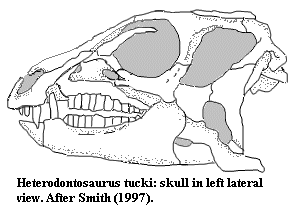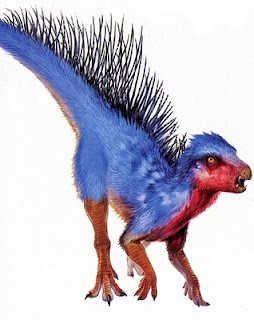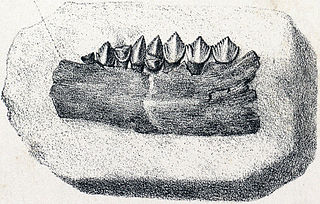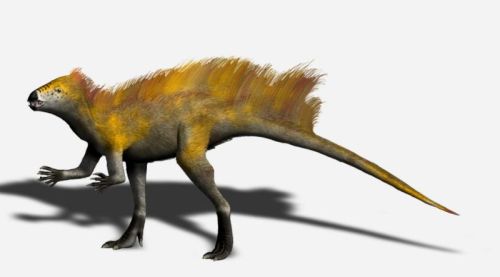Ornithischia: Heterodontosauridae
Taxa on This Page
- Echinodon X
- Fruitadens X
- Heterodontosauridae X
- Heterodontosaurus X
- Tianyulong X
Heterodontosauridae
The heterodontosaurs were small bipedal Early Jurassic forms. They averaged about a metre in length. They are among the earliest and most primitive members of the dinosaurian suborder Ornithopoda, which was to attain great importance during the Cretaceous, especially the Late Cretaceous period. (In some modern cladistic classifications, they are considered a "sister group" of, but not directly ancestral to, the Ornithopoda). All Ornithopods, including Heterodontosaurs, had very well-developed teeth, which means that they chewed their food in their mouths, rather than swallowed it and let it ferment and be ground up by gastroliths stomach stones) as did Anchisaurus and plateosaurid prosauropods. Once thought to be of late Triassic age, it is now known that the rocks in which their fossil remains are found date from the Early Jurassic. They were a short-lived group that never really ousted the predominant Prosauropods as top herbivore. Heterodontosaurs probably evolved from "fabrosaurs" or from early Scutellosaurs, such as Tatisaurus, possibly some time in the early Hettangian:
The Heterodontosauridae were bipedal forms that foraged 1 meter above the ground. The skull was sturdily built and had a well-developed dentition with robust, closely spaced cheek with distinct wear facets along the length of the tooth row. These dinosaurs would have been capable of processing relatively tough plant material (Weishampel 1984; Galton 1986).
Terrestrial Ecosystems Through Time, pp.356
As with the Carnian rhynchosaurs and the Norian and Rhaetian melanorosaurids, the heterodontosaurs seem to have experienced a brief period of diversity, before becoming extinct, possibly as a result of changing vegetation patterns. Before they died out though, the Heterodontosaurs gave rise to one of the most successful and long-lived of the dinosaurian lines, the hypsilophodontid and dyrosaurid dinosaurian "gazelles", which attained world-wide distribution during the Jurassic and Cretaceous.
Heterodontosaurids are known mostly from skull material, with distinctive tusks found in most individuals. They may be closer to the marginocephalians than to the ornithopods, due to their jugal (cheek-area) bosses and tusks, which are also known in pachycephalosaurians. MAK991008.
Phylogeny.
In relation to other groups: Originally understood as basal Ornithopoda (e.g. Paul Olsen lectures, Weishampel et al.. 2003), heterodontosaurs are now considered either basal ornithischian (Butler et al. 2007, Zheng et al. 2009, Butler et al. 2011, Open Dinosaur Project) or stem marginocephalia (Xu et al. 2006, Dinosaur Supertree). The first option assumes the same Cerapodan and basal Ornithopod characteristics evolving independently (by convergence) in heterodontosaurs and ornithopods, the second implies mosaic evolution (the retention of primitive, "fabrosaur" like traits in more derived ornithischians). It also has the advantage of bridging the stratigraphic gap between early ornithischia (late Triassic / early Jurassic) and early marginocephalia (late Jurassic). We have assumed the latter hypothesis for the purpose of the phylogeny in this unit.
Within Heterodontosauridae: There is little commonality between the various heterodontosaur cladograms (Butler et al. 2011, Butler et al. 2011, Pol et al., 2011) other than tending to place Echinodon in a basal position and Heterodontosaurus as derived, in reverse of the stratigraphic sequence. This may however be an artifact of the cladistic analysis, as Heterodontosaurus is known from very complete remains, and Echinodon from very incomplete. For this reason we have not attempted o present a phylogeny for this group. MAK120309
Descriptions
 Heterodontosauridae: Heterodontosaurus, Fruitadens, Tianyulong
Heterodontosauridae: Heterodontosaurus, Fruitadens, Tianyulong
Small (1-2m, <20 kg); high-crowned cheek teeth with chisel-shaped crowns; denticles on distal 1/3rd of cheek teeth; large, caniniform teeth on premaxillae & dentary; small tusks perhaps restricted to males; teeth absent from tips of jaws (probable beak); enamel thickened on labial side of upper teeth & lingual side of lowers; neck short; ossified tendons on last dorsal, but not caudal vertebrae; tail long; powerful arms with possible digging ability; tibia & fibula fused; forelimbs markedly smaller than hindlimbs; astragalus & calcaneum likewise fused to crus; horizontal posture, but bipedal; may have dug for food.
Image: originally after In Hand Museum (former site), with osteology corrected and some details altered per Smith (1997).
Links: DinoData: Heterodontosauridae; Heterodontosaurus; Heterodontasaurus Tucki; Heterodontosaurus - Enchanted Learning Software; ornithischia; Untitled Document; Heterodontosauridae Dutch); The Natural History Museum's Dino Directory; Heterodontosauridae; Mikko's phylogeny); DINOSAURS- Family Heterodontosauridae (brief discussion); Dinosaurs-Exam 3 Notes AKA- Adrian's Uber-Notes; HETERODONTOSAURIDS; Heterodontasaurus Tucki; Ornithischia.
References: Galton 1986); Smith 1997); Weishampel 1984). ATW030426.
Heterodontosaurus tucki Heterodontosaurus tucki Crompton & Charig 1962
Horizon: Upper Elliot Formation, Cape Province, South Africa (Hettangian / Sinemurian).
Remains: 2 complete skulls, 1 associated with a complete skeleton, fragmentary jaw
Comments: The best-known heterodontosaurid. A largely complete skeleton is known, showing relatively large, powerful hands and arms, including a strong thumb claw. Lycorhinus angustidens Haughton 1924, known from an isolated dentary, may be a synonym. Abrictosaurus consors Hopson 1975 (= Lycorhinus consors Thulborn 1974), a smaller form with smaller tusks, may be a juvenile or a female of the same or a different but related species. Lanosaurus scalpridens Gow 1975 known only from an Isolated maxilla from the Upper Elliot Formation, Orange Free State, South Africa (Late Hettangian / Sinemurian) has since been identified with Lycorhinus. In short, and following the orientation of Paul 2010, the original diversity of South African heterodontosaurs can be reduced to one or at most two species. However authors of several recent cladistic studies (Butler et al. 2011, Pol et al.., 2011) regard Heterodontosaurus, Abrictosaurus, and Lycorhinus as three distinct species. Dianchungosaurus lufengensis Yang 1982, once considered a contemporary heterodontosaurid from China (Dark Red Beds, Lower Lufeng Series Yunnan, Hettangian/Sinemurian) turned out to be a chimera of prosauropod and mesoeucrocodylian remains. MAK120309

Tianyulong confuciusi X.-T. Zheng, H.-L. You, X. Xu, and Z.-M. Dong, 2009
Horizon: Western Liaoning Province, China. Originally reported as being from the Early Cretaceous Jehol group, but actually from the Tiaojishan Formation, dating from the late Jurassic (Wikipedia)
Comments: Notable for the row of long, filamentous integumentary structures apparent on the back, tail and neck of the specimen. The similarity of these structures with those found on some theropods suggests their homology with feathers and raises the possibility that the earliest dinosaurs and their ancestors were covered with homologous dermal filamentous structures that can be considered primitive feathers ("proto-feathers"). (Wikipedia)
Image: Life reconstruction of Tianyulong confuciusi. Artwork by Xing Lida, from Zimmer, 2011), via Fantasy Game Book, Feathered Dinosaurs and the Dinosaur Lag Effect
Fruitadens haagarorum Butler, Galton, Porro, Chiappe, Henderson, and Erickson, 2009
Horizon: Middle Morrison Formation (Early-Mid Tithonian) of Colorado.
Comments: lower "canine" but appears to lack the upper counterpart; has replacement teeth. A diminutive form, 65-75 cm long, known from partial remains from at least four individuals of varying stages of growth. (Thescelosaurus). MAK120309

Echinodon: Owen 1861. E. beckelsi Owen 1861.
Range: Late Jurassic or Earliest Cretaceous of England.
Phylogeny: originally Thyreophora: (Scutellosaurus + Eurypoda) + *.; now considered a basal heterodontosaur
Links: DinoData: Echinodon; ECHINODON; Paleontology and Geology Glossary: E; DinoDictionary.com | E - Dinosaurs; Dinazors o'Dorzet, Gyde fer Grockles; ?????? ??? (Japanese).
Note: Echinodon becklessi Owen 1861 is a small (60 cm) heterodontosaur (previously considered a basal thyreophoran) from the Tithonian (Late Jurassic) or Earliest Cretaceous of England. Some North American materials may also be referred to this taxon. This has since been named Fruitadens haagarorum. The remains and characteristics of Echinodon are discussed in detail in the discussion on Ornithischia. ATW020807 MAK020420. revised MAK120309
Image: Lithograph showing teeth and jaw fragments of Echinodon, found in Dorset by Samuel Beckles. From A History of British Fossil Reptiles, by Richard Owen, Lacertians Pl. 11 ; via Wikipedia; public domain
checked ATW060211, revised MAK120309


